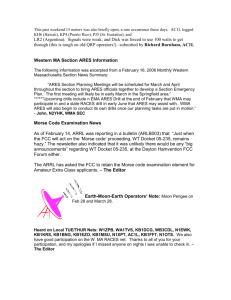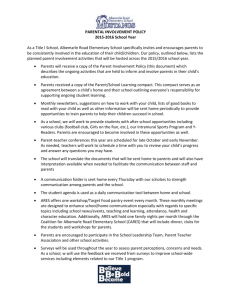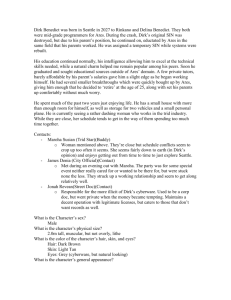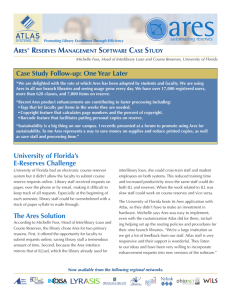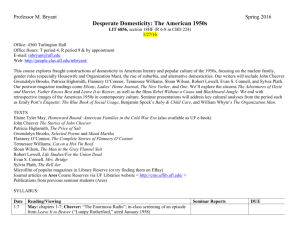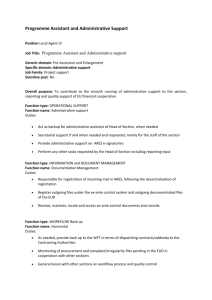DOC - Big Bend Amateur Radio Club
advertisement
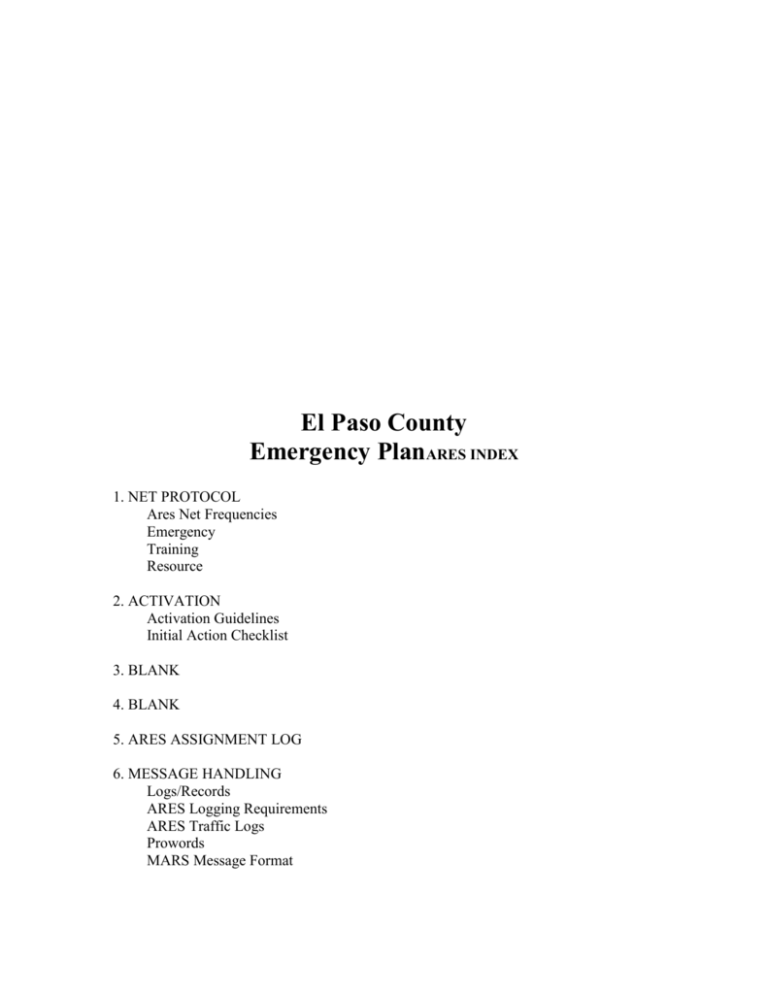
El Paso County Emergency PlanARES INDEX 1. NET PROTOCOL Ares Net Frequencies Emergency Training Resource 2. ACTIVATION Activation Guidelines Initial Action Checklist 3. BLANK 4. BLANK 5. ARES ASSIGNMENT LOG 6. MESSAGE HANDLING Logs/Records ARES Logging Requirements ARES Traffic Logs Prowords MARS Message Format 7. MISCELLANEOUS Purpose/Definitions Confidentiality Training Standard Operating Procedures Identification Cards ARES/RACES Repeaters Know Your Area Liability Membership Survival Bags El Paso Standard Power Connector EMP Protection Beaufort Wind Scale NWS El Paso (Spotter Call-in Criteria) Individual Public Service Activity Report Worksheet Handling Formal Messages (Radiograms) Via Any Mode Short-Term Public Service Event 8. BLANK 9. READY REFERANCE ANNEX Basic Communications Skills Local Repeater Data Input/output, PL Tones Required, etc… Radio Operators Notes: (Data for your personal brand of equipment) setting/clearing memory setting/changing PL tones any other information peculiar to your radio(s)1. NET PROTOCOL ARES FREQUENCIES The local ARES Information Net (Open Net) is 146.52 MHz (simplex). The first person to check into the frequency will assume NCS until the Emergency Coordinator or the Assistant Emergency Coordinator checks in. The local ARES Resource Net is on the 146.70 repeater. If the repeater is down the Resource Net will be on 146.70 simplex. This will be announced in the preamble. rev 11/2003 TRAINING Training for Amateur Radio Emergency Service (ARES) members shall be coordinated under the direction of the ARES Emergency Coordinator. ARES members will participate in the locally sponsored or endorsed drills or exercises under the direction of the Emergency Coordinator. ARES members should be thoroughly familiar with the Areas assigned to them and for assuming primary responsibility concerning that Area and all related topics. El Paso ARES training nets will be held when needed on __________mHz. Training meetings will be held monthly unless substituted by a training net/exercise/emergency. Members will participate in local SET-type emergency drills. Net Control will rotate and be handled by a roster. The roster will list a primary and an alternate Net Control. Additional activities, both independent and in support of relief and response agencies, are highly encouraged. All ARES operators will operate strictly in accordance with current FCC Rules and Regulations. Local practices, procedures, and traditions will be observed (unless otherwise overridden by FCC, DEM, or OEM) whether written or not. Non-standard practices are not allowed (except when such practices are absolutely required by an overwhelming urgency such that otherwise standard practices must be disregarded). rev 10/2002 2. Activation ACTIVATION GUIDELINES There are four levels of ARES activation. They correspond with FEMA, DEM, and local Emergency Management policies. From the lowest to highest, these are: Condition 4. Used to indicate civil unrest, tensions increasing (as defined by the Chief of Police), or any other advisory that should be brought to the attention of on-duty personnel. Review and follow the INITIAL ACTION CHECKLIST in the Emergency Plan. Wilderness Protocol is established at this time. Monitor 146.52 MHz simplex beginning at 0700, 1000, 1300, 1600, 2100, and 2200 hours local for five minutes. All messages will begin with a LiTZ signal (Long Tone Zero). Top off all batteries with a fresh charge. Continue with daily routines, but be aware. Condition 3. Includes a civil unrest risk (as defined by the Chief of Police). The Emergency Coordinator or the Assistant Emergency Coordinator will establish an open net on the ARES Information Net frequency. All communications, support equipment, and facilities should be put in a “pending-use” mode. Upgrade awareness. Condition 2. Includes civil disorder (large-scale localized violence and law-breaking begins), Strategic Warning as issued by the President, other official activation. The Emergency Coordinator or the Assistant Emergency Coordinator will establish a formal net (directed net) on the local 2-meter Tactical frequency. A Resource Net will be established (if required). First shift personnel will be put on 24-hour standby status, mobile equipment and supplies are loaded, full preparation for deployment. This is a significantly elevated condition of alert. Condition 1. Includes flooding occurrence, civil disorder reaches riot proportions, a major accident, or natural disaster occurrence without warning (i.e. train wreck, large gas leakage, explosion, or major fire). EOC fully operational, liaison functions established. ARES operators are dedicated to the Emergency Management organization for specific response and recovery functions. All nets are directed nets. ARES operators simultaneously prepare for extended operations such as Disaster Control, Shelter Operations, Damage Assessment, Emergency Recovery, as appropriate or as directed. All actions are organizational, not independent. rev 12/2003 INITIAL ACTION CHECKLIST Before responding for duty as an ARES volunteer the following conditions must be met: 1. Be sure you and your family are safe and secure. 2. Be sure your property is secure. 3. Monitor NOAA Weather Radio, and/or KFOX Channel 14 (Cable Channel 8) for Emergency information from Emergency Management. 4. Tune to ARES Information Net frequency (See ARES Frequencies), and obtain instructions from the NCS. 5. Determine the level of activation and get to that level as soon as possible. (See Activation Guidelines) When ready for deployment get additional instructions from NCS. 1. Obtain assignment and tactical call sign. 2. Get tactical net frequencies. Check in with served agency with “Survival Bag”. (See Survival Bag) 3. Initiate an “ARES Traffic Log”. (See ARES Traffic Log) 4. Use the “ARES Traffic Log” to record messages handled. 5. Use an ARRL formal message form (FSD-244) when precise records are required. Be sure all messages are signed properly from served agency. 6. Use tactical call sign for your assignment location. However, observe the FCC rules for station ID. 7. Monitor your assigned frequency AT ALL TIMES. rev 12/20033. Blank 4. Blank5. ARES ASSIGNMENT LOG ARES ASSIGNMENT LOG DATE ___/ ___/ _____ INCIDENT: _________________ NAME/CALL SIGN TIME TACTICAL CALL SIGN/LOCATION __________________ _____ ______________________________________ __________________ _____ ______________________________________ __________________ _____ ______________________________________ __________________ _____ ______________________________________ __________________ _____ ______________________________________ __________________ _____ ______________________________________ __________________ _____ ______________________________________ __________________ _____ ______________________________________ __________________ _____ ______________________________________ __________________ _____ ______________________________________ __________________ _____ ______________________________________ __________________ _____ ______________________________________ __________________ _____ ______________________________________ __________________ _____ ______________________________________ __________________ _____ ______________________________________ __________________ _____ ______________________________________ __________________ _____ ______________________________________ __________________ _____ ______________________________________ __________________ _____ ______________________________________ rev 6/2003 6. MESSAGE HANDLING ARES LOGGING REQUIREMENTS LOGGING REQUIREMENTS for ARES OPERATIONS: [LVL 1, LU 8] 1. All Message Traffic, Formal and Informal must be entered into the ARES Logs. 2. LOGGING TRANSMITTED FORMAL MESSAGES: The station entering the message into the Net will proceed with logging as follows: a. Enter the MESSAGE NUMBER b. Enter the DATE/TIME message received from Authorized Official c. Enter the DATE/TIME message transmitted d. Enter the ADDRESSEE e. Enter the SENDER (author of message) f. Enter TACTICAL CALL of station the message was sent to g. MAINTAIN all Original Messages in a folder in Numerical Sequence 3. LOGGING RECEIVED FORMAL MESSAGES: The station receiving the message will proceed as follows: a. Enter the MESSAGE NUMBER b. Enter the DATE/TIME the message was received c. Enter the DATE/TIME the message was delivered d. Enter the NAME of individual to whom the message was delivered e. Enter the FCC Call of the Operator receiving and delivering the message 4. LOGGING INFORMAL TRAFFIC Each station handling INFORMAL (unwritten) traffic will proceed as follows: a. For CRITICAL RESPONDERS: 1. Enter the DATE/TIME of the message traffic 2. Enter the NAME of the individual speaking over your radio 3. Enter the TACTICAL CALL of the station contacted b. For ALL OTHER informal messages: 1. Enter the DATE/TIME of the message 2. Enter the TACTICAL CALL of the called station 3. Enter the SUBJECT of the call 5. OPENING/CLOSING and MAINTAINING an ARES LOG: a. The Operator(s) opening/closing and/or maintaining the Log should: 1. Record their FCC CALL and NAME (Control Operator) 2. Enter the DATE/TIME into the Log 3. Enter IMPORTANT EVENTS that take place a. Lunch breaks, Relief breaks b. Power failures, Equipment failures c. Need to relocate your equipment d. Any other significant event that could impact operations 6. Keeping an ARES LOG: Since the data to be logged is so varied in nature, it is best to use a Free Form of Logging. That is to say, that Logs kept on ruled paper in a 3-ring binder will better serve than a series of forms. This is how Ships Logs are maintained. Ship's Logs are legal documents. PROWORDS Prowords are pronounceable words or phrases that have been assigned standard meanings for the purpose of expediting message handling. ARRL publications describe a wide variety of such words. Operators should familiarize themselves with the ARRL terms and every effort should be made for clarity and uniformity of transmissions. Common terms are listed here for convenience. Proword Explanation ALL AFTER The part of the message to which I have reference is all that which follows ________________. ALL BEFORE The part of the message to which I have reference is all that which precedes _______________. BREAK I hereby indicate the separation of the text from other parts of the message. CORRECTION An error has been made in this transmission. The correct version follows. DISREGARD This transmission is in error. Disregard it. FIGURES Numerals follow. FLASH Ahead of all other messages. Interrupt messages with lower precedence. I SAY AGAIN I am repeating transmission or part. I SPELL I shall spell phonetically the next part. OUT This is the end of my transmission to you and no answer is required or expected. OVER This is the end of my transmission to you and a response is required or expected. RELAY Transmit this message to those addressed. ROGER I have received your last transmission satisfactorily. The CW equivalent is QSL. SAY AGAIN Repeat all of your last transmission. SILENCE, SILENCE, Cease transmission immediately. Silence will be maintained until instructed to resume SILENCE SILENCE LIFTED Resume normal transmission. Silence can be lifted only by the station imposing it or higher authority. SPEAK SLOWER Your transmission is at too fast. Reduce speed of transmission. CORRECT You are correct or what you have transmitted is correct. WORDS TWICE Communication is difficult. Transmit (ting) each phrase (words or code group) twice. MARS MESSAGE FORMAT When a message involving the Military Amateur Radio Service (MARS) is required the format will be as follows: 1.From: 2.To: 3.ACTUAL INCIDENT or EXERCISE 4.Subject: 5.Reference: Event identifier/State a.Incident/Location/Time b.Emergency Medical Facility Status c.Local Transportation Status d.General Damage Characteristics e.Area Utilities Status f.Communications Status g.Information Source/Date & Time ACTUAL INCIDENT or EXERCISE Indicate whether giving information, asking for information, asking for supplies or materials. rev 5/20027. MISCELLANEOUS PURPOSE/DEFINITION The primary objective shall be to provide backup emergency communications services to Public Safety, Emergency Management, and relief agencies when required to do so in the absence of the primary communications infrastructure. The secondary objective shall be accurate and complete communications. Underlying consideration is given to operation under adverse conditions and for extended duration. These objectives will be advanced through organized training and preparedness. Operators in the Amateur Radio Emergency Service (ARES) function as part of an organization. ARES operators will be given priority consideration and recognition over untrained and/or non-member operators in emergency situations. ARES members must remember at all times that they individually appear to be the public face of these operations and/or amateur radio in general. The highest standards will be regarded as the basic foundation of operations. ARES operators will provide the working backbone of El Paso emergency communications. During disaster situations ARES will operate under the guidance and direction of the District Officers of the Radio Amateur Civil Emergency Service (RACES). A communications emergency is a situation in which a potential, immediate, or sustained harm to human life or property could be prevented, mitigated, or relieved through the efficient use of the facilities and expertise of amateur radio operators. Such expertise may be in addition to or in place of “normal” or “official” means of communications. Operators may work independently, or in co-operation with or support of local government or relief agencies. ARES responsibility is limited solely to providing communications but that shall neither enhance nor diminish obligations or privileges of members as citizens. rev 6/2002 CONFIDENTIALITY Amateur Radio Emergency Service (ARES) members should at all times consider their communication service confidential. Operators do not perform their missions in hope of obtaining publicity, special privileges, or reward. Additionally, served agencies have not given explicit permission for outside use of information necessary to achieve there assigned duties. A radio operator may not divulge personal information concerning victims or potential victims. REFER ALL PUBLIC INFORMATION INQUIRIES TO THE DESIGNATED PUBLIC AFFAIRS CONTACT and be aware that even “friendly, off-the-record” comments are unauthorized. Radio operators serve at the request and pleasure of the served agency and must always appear as a competent professional. No special powers or privileges are granted by virtue of providing radio communication capabilities. rev 4/2002 TRAINING Training for Amateur Radio Emergency Service (ARES) members shall be coordinated under the direction of the ARES Emergency Coordinator. ARES members will participate in the locally sponsored or endorsed drills or exercises under the direction of the Emergency Coordinator. ARES members should be thoroughly familiar with the Areas assigned to them and for assuming primary responsibility concerning that Area and all related topics. El Paso ARES training nets will be held when needed on __________mHz. Training meetings will be held monthly unless substituted by a training net/exercise/emergency. Members will participate in local SET-type emergency drills. Net Control will rotate and be handled by a roster. The roster will list a primary and an alternate Net Control. Additional activities, both independent and in support of relief and response agencies, are highly encouraged. All ARES operators will operate strictly in accordance with current FCC Rules and Regulations. Local practices, procedures, and traditions will be observed (unless otherwise overridden by FCC, DEM, or OEM) whether written or not. Non-standard practices are not allowed (except when such practices are absolutely required by an overwhelming urgency such that otherwise standard practices must be disregarded). rev 10/2002 STANDARD OPERATING PROCEDURES Standard operating procedures are not a specific, finite set of rules and practices but rather the opposite of non-standard procedures. The term also includes the concept of standardized procedures. Universally understood, routine practices facilitate communication in an efficient and orderly manner and do not require “re-translation” by the transmitting or receiving station. Generally, concepts printed in the ARRL Operating Manual serve as the basic foundation for Standard Operating Procedures. Items of special interest include: 6.Use only current IUT phonetics at all times. 7.Allow some lag time between conversations for break-in traffic (on repeaters, this generally means waiting for the “courtesy beep”). 8.Keep all transmissions short, accurate and precise – eliminate unnecessary transmissions entirely. 9.Use good microphone techniques (speak across the mic – not directly into it) and good diction and enunciation to avoid distortions and misinterpretations. 10.Complete the mission – are you sure the message got through as intended? Perhaps most important: 11.THINK – before, during, and after transmission. 12.THINK – before, during, and after reception. A proficient operator will always use these techniques under disaster/emergency conditions. By routinely using the same procedures during common communication, a habit will be established and training re-enforced. Switching between disaster/emergency rules and daily rules is effectively requiring the unnecessary learning of two different (but related) languages – and then having to decide when to use each. rev 4/2002 IDENTIFICATION CARDS Amateur Radio Emergency Service (ARES) identification cards (FSD224) will be issued to each individual when they complete the Registration Form (FSD 98), and attend their first meeting. Members will have a laminated FSD224 with a picture. All FSD224 cards will bear the members name, call sign, and the Emergency Coordinators signature on the front side. The member will sign on the reverse side. All cards will have an expiration date, and all will expire on the same date. The Emergency Coordinator will be responsible for maintaining membership qualifications. The FSD224 cards may be revoked at any time and must be surrendered upon termination of participation. Volunteer Operators will be issued a Temporary Identification Card (FSD224) when they are processed through the Staging Area. The Identification Cards will be marked “Temporary” where the name is. It will have a “Number” in the space where the picture goes. The Identification Cards will expire at the end of their assignment, and must be surrendered to any ARES member or the Emergency Coordinator. All cards and materials are for identification and operating purposes only. Possession or use neither expands nor restricts operators’ rights as citizens. All operators must conform to radio privileges (implied or expressed) of membership as stated in current FCC or local procedures. rev 3/2003 ARES/RACES REPEATERS The El Paso ARES/RACES repeaters are special purpose repeaters established to provide a supplementary means of VHF/UHF communications during emergency or disaster situations. Only emergency or disaster traffic should be conducted on these repeaters. Routine conversations should be conducted via simplex or other available means. Control Operators are Texas RACES Officers. El Paso ARES is a voluntary amateur radio organization designed to support emergency and disaster relief and response agencies. All facilities of the organization are maintained solely to enhance that mission. rev 4/2002 KNOW YOUR AREA ARES members are responsible for planning and developing the disaster communications capabilities of their assigned Areas (generally, their home ZIP codes). Implementation of such planning should be based on RACES and ARES resources and coordinated with District and served-Agency plans. The Planning process includes a hazard, needs, and existing-capabilities assessment analyzed according to the potential impact of the risk. Use of the FEMA HICA-MYDP (CHIPS) format is generally helpful. Actual, first-hand, visual familiarity with existing and changing conditions in the assigned Areas is necessary to meaningfully plan communications needs. Initial responsibility is in the assigned Area. Perspectives should include contiguous Areas, impacting, and affected Areas. Thorough understanding of District-wide operations is developed through co-operative interchange of Plans and ideas. Operators should prepare for service in their Areas but remain flexible for reassignment and support use. Regular participation in the routine ARES net is the expected beginning of the interchange cycle. OPERATORS SHOULD NOT SPONTANEOUSLY RELOCATE OR “ROAM” unless specifically requested to do so or do so for immediate personal safety reasons. District and served-Agency responses are based on all foundation-levels providing information and service in a predictable manner from, to, and as expected in their assigned Areas according to established Plans. Inefficient duplication of efforts and unanticipated gaps are created if operators do not function within the concept of Areas and border-based Plans. Mitigation, response/relief, and recovery efforts require utilization of co-operative expectations. Geographic dispersal and personal knowledge of community realities form a foundation for trustworthy and meaningful understanding of emergency/disaster conditions. Essentially, operators should think and function under a concept of “KNOW YOUR AREA”. rev 4/2002 LIABILITY Operators should be prepared to accept the consequences of their actions both as to commissions and omissions. Accuracy and reliability must remain foremost in organizational concepts. Operators are considered volunteers donating their efforts and expertise at their own risk. Served agencies assume no liability for loss or injury to the operator or his/her property or equipment. No special powers are inferred, implied, or granted by virtue of membership or activation except as stated in the Plan. Under no circumstances should an operator conduct ARES affairs in contradiction of good judgment, good citizenship, and standard radio practices. ARES members must not maintain ARES patches in conjunction with club, contest, or other amateur radio insignias. Only authorized ARRL, or Skywarn insignias should be associated with the ARES designations. In order to ensure efficient and proper organizational interface, an obvious and appropriate chain-of-command will be made apparent to all served agencies during any operation. Command structure will be maintained only through this chain. A clear philosophy of jurisdiction must be presented to served agencies. Member ”jumping the chain-of-command”, exceeding authority, acting as response units without served agencies requests, using ARES to promote personal interest, or in any other way weakening the Program, will be subject to membership termination and permanent exclusion from ARES activities solely and finally at the discretion of the ARES District Emergency Coordinator (DEC), as appropriate to the organization. A former member must return all ARES materials to the DEC promptly. Presenting oneself as a member of ARES generally obligates the operator to a significantly higher standard of performance than otherwise expected by licensees. MEMBERSHIP ARES members are expected to actively and routinely participate in meetings and nets/exercises/emergencies. An “active” level is judged with a value of approximately 80% assigned to attending ARES meetings and 20% assigned from nets/exercise/emergency participation (each primarily on a quantitative basis). All membership cards in the jurisdiction expire at the same time and never issued for more than two years. No operating privileges are inherent in ARES membership alone, such privileges are derived only from the amateur license. Membership is valid only in the jurisdiction of the signing Emergency Coordinator, though reciprocity and exchange may be accepted, especially during emergency situations. The ARES Emergency Coordinator must assure that mission assignments are fulfilled. Members who are disruptive of the organization effort or who willfully do not conform to training or operating guidelines will be terminated from ARES at the discretion of the Emergency Coordinator. All members must constantly strive for the highest ideals of cooperative organizational effort. rev 10/2002 SURVIVAL BAGS Personal safety, comfort, and survival must be provided for before service to the community or agencies can be considered. Normal services and routines—with their support functions—will, by definition, be limited or entirely unavailable for a period after a disaster. Additionally, communications operators may be asked to provide service from locations other than their normal site. A psychological stress will be created if the operator is also concerned about the status of family or other concerns. Three categories of Survival Bags should be prepared in advance and tailored to individual needs and desires. First, a 72-hour bag of basic survival items should be available. Remember the family pets also. A radio bag should include required items to setup and operate a station. The third bag is a heavy equipment bag. Refer to the Emergency Communications chapter in the ARRL Operators Manual for items needed in the bags. All units should be prepackaged and individually portable without assistance. Store the bags in diverse locations and keep some materials pre-loaded in your vehicles. Keep contents in tact but rotate items that may deteriorate or spoil. rev 8/2002 EL PASO STANDARD POWER CONNECTOR Anderson Powerpole PP30 series connectors (Part # Black 1330G4, Red 1330) for use in promoting compatibility and interchangeability among personal UHF/VHF radio equipment at disaster sites. Polarity should always be verified prior to connecting to radios and power supplies. rev 4/2002 EMP PROTECTION Most authorities currently believe that an initial enemy attack would be aimed to disrupt communications facilities by exploding a nuclear device in the upper atmosphere (approximately 200 miles above the earth). This would produce an Electro-Magnetic Pulse (EMP) that would affect all forms of electrical and electronic mechanisms but not result in any radiation danger to the population. The exact effects are not yet fully known or predictable. In anticipation of that initial communications disruption, these actions should be taken to afford some protection from Electro-Magnetic Pulse: A. Radio transmitters and/or receivers 13.Disconnect power cords, tightly roll, and wrap with aluminum foil. 14.Disconnect antenna lead-ins at the set and isolate the loose ends as far away from metallic objects as possible to prevent arching. B. All transistorized equipment 15.Disconnect from external power source, tightly roll cord, and wrap with aluminum foil. 16.Reduce antenna length to minimum length (generally, less than 30 inches) or disconnect it. C. Computers Disconnect all external lines, tightly roll, and wrap with aluminum foil. D. Telephones 1. Disconnect all but one phone from the main line. 2. Roll disconnected cords into a small, and wrap with aluminum foil. E. Televisions and CRT equipment 1. Disconnect power cords, tightly roll, and wrap with aluminum foil. 2. Disconnect antenna lead-ins at the set and isolate the loose ends as far away from metallic objects as possible to prevent arching. rev 5/2002 BEAUFORT SCALE SCALE NAME MPH DESCRIPTION 0 calm <1 smoke rises vertically 1 light air 1-3 direction of smoke, not vanes 2 light breeze 4-7 felt on face, leaves rustle, vanes move 3 gentle breeze 8-12 leaves & twigs in constant motion; extends light flag 4 moderate breeze 13-18 raises dust & small paper; small branches move 5 fresh breeze 19-24 small trees in leaf sway; crested wavelets on inland lakes 6 strong breeze 25-31 large branches in motion; wires whistle; umbrellas difficult 7 near gale 32-38 whole trees in motion; walking difficult 8 (fresh) gale 39-46 breaks twigs; impedes progress 9 strong gale 47-54 slight structural damage; shingles removed 10 whole gale 55-63 trees uprooted; considerable structural damage 11 (violent) gale 64-72 rare; widespread damage 12 hurricane 73-136 devastation NATIONAL WEATHER SERVICE EL PASO Spotter Call-in Criteria (guidelines, not absolute law) (800) 874-6755 Flash Flooding: Is described as any potentially dangerous flooding of arroyos or low water crossings. Heavy Rain: Report half inch within 30 minutes. Report any significant ponding or flowing of water. Hail: Report hail stones half inch in diameter (see estimation table below). Tornado, funnel cloud, or rotating wall cloud: Report time, location, and movement. Winds: Report estimated 40 mph or more (use Beaufort Scale). Report distinct downburst (descending “bubble” or “rain/dust foot”). Visibilities ¼ mile or less: Report when due to fog, blowing dust, or heavy precipitation. Snow: Desert: Mountains: Report when accumulation begins. Report when greater than 2 inches accumulates. Freezing Rain: Report when freezes on contact with outdoor surfaces. Estimating Hail Sizes ¼ inch: pea ¾ inch penny One inch quarter 1.25 inch: 1.75 inch: 2.50 inch: half dollar golf ball tennis ball 2.75 inch: 4 inch 4.50 inch: baseball grapefruit softball INDIVIDUAL PUBLIC SERVICE ACTIVITY REPORT WORKSHEET Handling formal messages (radiograms) via any mode 1 point for each message handled. (See ARRL’s Public Service Communications Manual; NTS Section for explanation of how to count your individual messages.) Originated: Sent: Received: Delivered: Total number of messages handled: Number of amateurs participating: Event start date/time: Event end date/time: Duration of event (hours): Total Man-hours: Was repeaters used? How many? Types of Net(s) used. Frequency(s) used. Repeater Call sign: Names of agencies receiving communications support: Other comments (Attach photos, newspaper clippings etc.): ____________ ______________________ _____________________ (Callsign) (Print Name) (Signature) PUBLIC SERVICE ACTIVITY REPORT WORKSHEET Short-Term Public Service Events 5 point per hour (or any portion thereof) of time in either coordinating and/or operating in public service event; no limit. Air Show: Parade: Simulated Emergency Test: SKYWARN: Training drills or exercise (specify): Transmountain Run: Other (Specify): Total number of messages handled: Event start date/time: Event end date/time: Duration of event (hours): Total Man-hours: Type of Communications Equipment Used: Base Station: Mobile Station: Portable: Digital Modes: Was repeaters used? How many? Types of Net(s). Traffic Net: Tactical Net: Resource Net: Information Net: Frequency(s). Repeater Call sign: Name(s) of agency(s) receiving communications support: Other comments (Attach photos, newspaper clippings etc.): Call Signs, Names, and types of equipment used by amateurs participating. Also estimate the cost of the equipment used by amateurs: ____________ (Call Sign) ______________________ (Print Name) _____________________ (Signature)8. BLANK 9. READY REFERANCE ANNEX BASIC COMMUNICATION SKILLS FOR ARES INTRODUCTION: EMCOMM NOTE: INFORMATION FOR THIS SERIES OF INSTRUCTION IS TAKEN FROM THE ARRL PUBLICATIONS THAT DEAL WITH EMERGENCY COMMUNICATIONS (EMCOMM), AS FOLLOWS: Amateur Radio Emergency Communications Course, LEVELS I, II, and III ARES Field Resources Manual ARRL Public Service Communications Manual These methods and skills are the result of "Trial-by-Fire", in that they have been developed, tested, retested, modified and tested again, repeatedly. These methods and skills have proven effective in Floods, Fires, Earthquakes, Tornadoes, Hurricanes and just about every other type of disaster that Humans can be exposed to, including disasters involving Motor Vehicles, Airplanes and Trains. We are not reinventing EMCOMM. Emcomm is the ARRL acronym for EMergency COMMunications. To Be Effective in our Efforts to be of Assistance in Emergencies: We must work to develop Skills and Techniques that will complement our willingness to serve. As Licensed Operators, we are very familiar with the Casual Chats and Banter that is carried on Daily on the Local Repeaters. This type of Operating IS NOT conducive to the Rapid transfer of vital information in an Emergency Situation. Having a thorough knowledge of all of your radio's functions is essential for efficient operation under stress. Much more is needed than just changing frequencies and talking. This Training effort, and material, is intended to give a good head start in satisfying the requirements for EMCOMM 1. WHY EMERGENCY COMMUNICATION SKILLS ARE DIFFERENT a. Messages can mean the difference between LIFE and DEATH b. Emergency communications are PURELY PROFESSIONAL NO chatter, Rumors or Speculation c. No broadcasting is permitted, no personal opinions d. Official authorized messages only 2. BASIC COMMUNICATION SKILLS a. Messages must get through to intended recipient 1. Clear and concise 2. Easily understood b. c. d. e. f. 3. Must be passed quickly 4. May mean the difference between loss of life (or property) Listening 1. Cannot hear if you are talking 2. Focus on your assignment 3. Headphones may be needed in a noisy location 4. Important information/data may be missed (or misunderstood) Microphone techniques 1. Must be used correctly 2. Talk across the mic element, not directly into it 3. Hold microphone close to your cheek 4. Speak at a normal rhythm if you normally speak rapidly, slow down speak in normal tones: do not whisper or shout 5. Enunciate clearly 6. Do not use VOX 7. Pause prior to keying the microphone another station may have emergency traffic, and this gives them a chance to be heard Brevity and Clarity 1. Each transmission should only contain the words necessary to pass the message 2. No chitchat or broadcasting 3. No non-essential chatter/ no speculation/ no rumors 4. Think before you speak 5. Say exactly what you mean 6. Complete one subject at a time. Do not mix messages Plain language must be used on Voice 1. No HAM jargon, no "Q" signals and no "10-Codes" 2. Use Pro-words 3. No such thing as "common spelling" Phonetics 1. Use ONLY the ITU phonetic alphabet 2. No humorous or cute phonetics 3. Numbers (figures) are pronounced individually g. Pro-Words 1. Clear, over, go-ahead, stand-by, roger 2. For Fills, "say again all before/after........." h. Tactical Call Signs 1. Will be assigned for each station 1. Must be used 2. Will immediately identify your station and the station that your traffic is destined for i. Calling with Tactical Call Signs 1. use tactical call of called station first, followed by your tactical call EX: Net, Aid3 this tells the NCS that you have traffic to pass and that Aid3 station is the calling station. You do not need to announce your FCC call sign at this time j. Station Identification 1. Give your FCC assigned call sign at the END of each complete exchange. WHAT IS A COMPLETE EXCHANGE? 2. During the information exchange, use only your tactical call sign 3. Information exchanges on emergency nets will NOT take ten (10) minutes to complete normally 4. Rendering your FCC call sign at the completion of each exchange serves two (2) purposes a. It satisfies the FCC requirement to identify at 10 minute intervals during an exchange, and at the completion of each exchange. b. Announcing your FCC call sign tells the NCS or the receiving station that you have NOTHING FURTHER, and that you are continuing to monitor the net. k. Completing a Call 1. Complete a call by giving your tactical call, AND your FCC call sign EX: Aid3, WA5KKY 2. The called station now knows that you have nothing further l. Habits to Avoid 1. Thinking out loud on the air 2. On-air arguments or criticism 3. Rambling commentaries 4. Shouting into the microphone 5. Cute phonetics 6. Identifying every time you key or un-key the mic 7. using 10-codes 8. Speaking without planning your message 9. Talking just to pass the time 3. ALLOWING CRITICAL RESPONDERS TO SPEAK DIRECTLY OVER THE RADIO...(level III, Pg. 125) a. Third Party Traffic is allowed by FCC Regulations [97.115(B)(1)] b. Often, the terminology used will not be part of the Radio Operators vocabulary 1. Most of us don't speak the language of Doctors, Paramedics, Firemen, Police Officers, etc. 2. Direct conversation between critical responders: saves time (time may be essential in life saving) eliminates errors in translation (which could cost lives) 3. The licensed operator is present, and is in control the radio 4. A record of the individual speaking over your radio should be noted note the NAME of the person note the DATE/ TIME of the third party traffic note the TACTICAL CALL of the other station in the contact THIS ABOVE DATA SHOULD BE PASSED TO THE EC ON STAND-DOWN. 4. WHAT YOU SEE (HEAR) THERE, LEAVE THERE a. At your assigned duty station: 1. You may be exposed to "INSIDER" (proprietary) information that should/must not be revealed outside of that establishment. THIS INFORMATION IS NOT TO BE DISCUSSED OUTSIDE OF THAT PLACE OF BUSINESS, WITH ANYONE. 2. Criminal Acts ARE NOT proprietary information and MUST be disclosed to proper authority. a. Who should be notified depends on the position / authority of the violator. b. Perhaps the safest bet is to notify the ARES EC, and let that individual determine the best approach to reporting. 3. It is extremely important that ARES volunteers establish and maintain a trusted and respected relationship with those we serve ITU PHONETIC ALPHABET A alfa B bravo C charlie D delta E echo F foxtrot G golf H hotel I india J juliet K kilo L lima N november O oscar P papa Q quebec R romeo S sierra T tango U uniform V victor W whiskey X x-ray Y yankee NUMBERS 1 one 2 two 3 three 4 four 5 five 6 six 7 seven 8 eight 9 nine (niner) 0 zero (never oh) M mike Z zulu The emphasis on spoken words and numbers is usually placed on the first syllable. PROWORDS Prowords that will be used are contained in the packet distributed by the Emergency Coordinator. GENERAL Please use only the ITU Phonetic alphabet, the numbers and the Prowords as listed. All should speak the same language. This aids clarity, and helps to limit repeats. LOCAL AREA REPEATERS REPEATER OUTPUT 145.010 145.110 145.330 145.410 146.700 146.880 147.060 147.140 147.160 147.200 147.240 147.300 147.280 147.320 147.360 144.390 146.620 224.820 53.55 442.125 442.250 442.550 442.825 442.950 443.400 444.200 447.500 OFFSET PL Packet + + + + + + + + + + + + + + + + - ARES No PL Port. 67 88.5 162.2 RACES No PL Closed 67 162.2 162.2 162.2 162.2 162.2 APRS 100 1MHz 103.5 100 100 100 67 100 100 103.5 448.125 449.925 - 100 100 rev 3/2004 Radio Operators Notes (Data for your personnel brand of equipment) Setting/Clearing memory, Setting/changing PL tone, any other information peculiar to your radio(s), etc…

